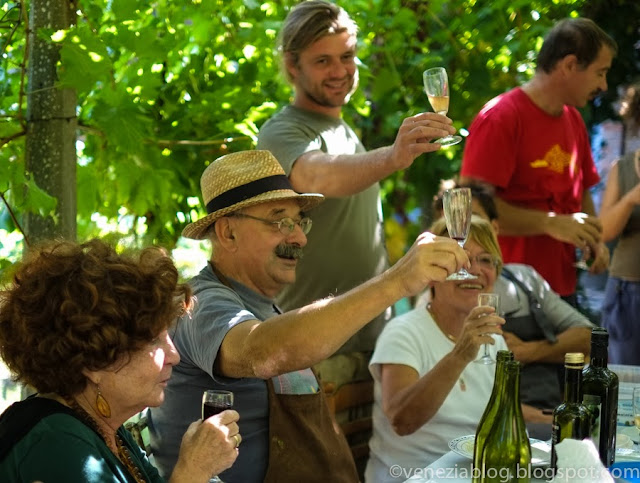 |
| Pausing for lunch beneath the grape arbors in the monastery of San Michele |
The old cantina in the 15th-century monastery on San Michele (pictured in my previous post) has been resuscitated and serves as the wine production facility not only for grapes harvested from within its own walls, but from other traditional Venetian vineyards, such as those within the walls of San Francesco della Vigna and I Carmelitani Scalzi, and from vines on Sant' Erasmo, Mazzorbo and Giudecca.
Franceschet's group has been recognized this year for its contributions to the culture of the Veneto by the Fondazione Masi, which provides a brief overview of the aims and activities of La laguna nel bicchiere in both English: http://www.fondazionemasi.com/eng/masi_prize/edition/339_Le%20Vigne%20di%20Venezia%20project
and Italian: http://www.fondazionemasi.com/ita/premio_masi/edizione/336_Progetto
An even more detailed account of the group's goals is available (in Italian) in the online cultural magazine Il ridotto di Venezia: http://ilridotto.info/it/content/laguna-nel-bicchiere-unaltra-venezia-%C3%A8-possibile
The group also has a closed Facebook group, to which one can apply for inclusion.
Of course, this is one of the group's busiest times of year; there's another vendemmia or harvest scheduled for Monday in an old vineyard hidden away near the Arsenale, to be followed by more stomping (or pigiare) on San Michele, which I doubt I can make because of work. But Jen and I and Sandro, too, all look forward to doing more with this group.
 |
| Flavio Franceshet, in hat at left, the director of La Laguna nel Bicchiere |
 |
| The multi-talented winemaker, musician, performer and poet, Gigi Miracol (who appeared 2 years ago in this blog as the winner of a poetry slam at Ca' Tron: http://veneziablog.blogspot.it/2011/09/poetry-competition-at-ca-tron.html) |
 |
| Picking the stems out of the stomped grapes |
 |
| A poem by Gianluigi Simonetti posted beside the entry to la cantina, and particularly well-suited to vineyards on a cemetery island |
For Part 1 of "Stomping Grapes & Making Wine on San Michele" go here: http://veneziablog.blogspot.it/2013/09/stomping-grapes-making-wine-on-san.html
For a short video of wine stomping taken on this day go here: http://veneziablog.blogspot.it/2013/09/winemaking-on-isola-di-san-michele.html











































